「定年女子」のワーク&ライフ レビュー
1986年に男女雇用機会均等法が施行されてから、早34年。それまでにないステージでキャリアをスタートさせた彼女たちの、定年に対する意識やライフスタイル、女性活躍社会における仕事観の把握を目的に、電通シニアプロジェクトでは「定年女子調査」(※)を実施しました。
調査によると、定年を意識し始める年齢は、平均50.7歳!定年前後の女性たちのプロフィールやリアルインサイト、今後のアプローチのヒントについて、3回連載で紹介していきます。

(※)定年女子調査: 60歳を定年と規定し、
●「プレ定年女子」:6~10年以内に定年予定の50~54歳女性
●「定年女子」:5年以内に定年予定の55~59歳女性
●「ポスト定年女子」:既に定年を経験した60~64歳女性と定義。
またポスト定年女子のうち仕事をしている人を「ポスト定年女子(仕事継続組)」、仕事をしていない人を「ポスト定年女子(仕事リタイア組)」とした。
詳細は巻末をご覧ください。
「定年女子」のライフヒストリーと女性活躍社会への道のり
定年をいよいよ間近に控えた「定年女子」は、これまでどんなふうに仕事と共に歩んできたのでしょうか。まず、より深く彼女たちを知るため、「定年女子」のワーク&ライフヒストリーや社会背景に注目します。
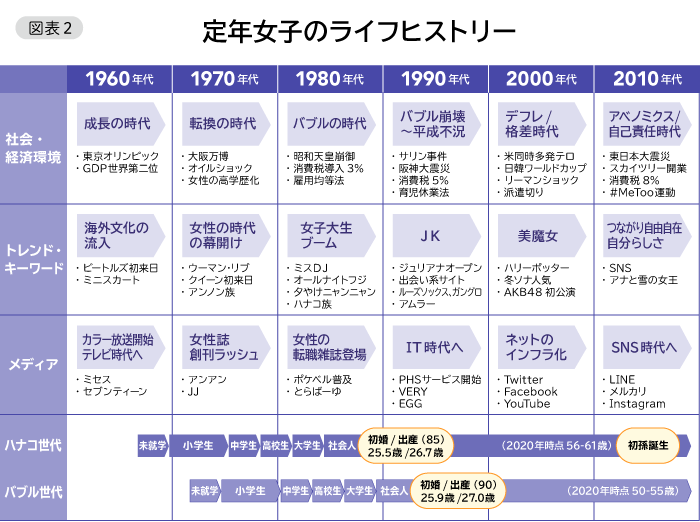
「定年女子」は女性として常に注目を浴びながら、道を切り開いてきたキャリアウーマンの草分け。
「定年女子」は雇用機会均等法1期生を含む、キャリアウーマンの草分け的な存在です。図表2の定年女子のライフヒストリーからもうかがえるように、高度経済成長のさなかに誕生、20代で女子大生ブームやバブルといった華やかな消費も経験し、男性社会の中で肩を並べながら走り続けてきた、働く女性のフロントランナーといえます。
また下記の図表3、4が示すように、社会の変化や行政の支援施策、進学率の向上などが、結婚や出産を経ても働き続ける女性や、キャリアアップを目指す女性たちの増えてきた背景となっています。
現在、女性の2020年(1月)の女性の労働力人口は2970万人。日本全体の44.4%を占めています。働く女性の割合も年々上昇していて、2019年時点で女性全体の53.3%。50~54歳では8割、55~59歳でも75%近くに達しています。いわゆる子育てと仕事を両立する人が増え、M字カーブのくぼみが平たんになるとともに、近年、働く中高年女性の割合も上昇しており、この傾向は今後も続くと考えられています。

【女性就労環境に関する各種法律の整備の推移】
●1986年:「男女雇用機会均等法」(雇用の分野における男女の均等な機会及び待遇の確保等に関する法律。その後、1997、2006、2015年改訂)
●1994年:「エンゼルプラン」(今後の子育て支援のための施策の基本的方向)
●1999年:「新エンゼルプラン」(重点的に推進すべき少子化対策の具体的実施計画)
●2005年:「次世代育成支援対策推進法」(10年間の時限立法)
●2016年:「女性活躍推進法」(女性の職業生活による活躍の推進に関する法律)
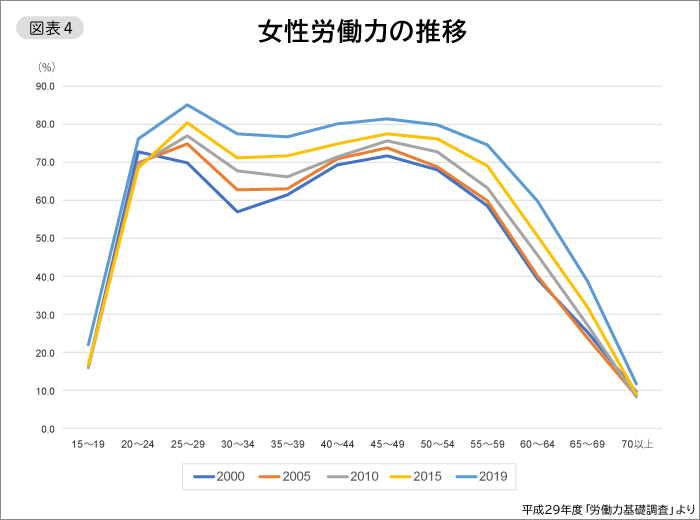
「定年女子」のリアルライフ
「定年女子」の歩んできたライフヒストリーと社会背景が見えてきたところで、次に彼女たちの、現在のワーク&ライフスタイルにフォーカスします。
「定年女子」の現在の暮らしぶりは子育てもひと段落。45%が配偶者と同居。一人暮らしは3割。
家族構成は、既婚:46.5%、未婚:29.0%、離別:22.5%、死別:2.0%。一人暮らしは31%、配偶者と同居が45%、父母と同居が22%、社会人以上の子と同居が19%となっています(重複あり)。年収は200~400万円が最多で、42.5%となっています。
「定年女子」の累計勤続年数は平均28.4年、4分の3以上がキャリア30年以上。管理職経験アリは約3割。
「定年女子」の累計勤続年数は平均28.4年で、4分の3以上の人が30年以上も働き続けてきました。1社で継続勤務してきた人は21.5%。約半数は現在の会社が3~5社目(48.5%)で、何社かを経験しながら働き続けてきたワークスタイルが多数派です。また、管理職を経験した人は27.5%となっています。
「定年女子」の休職・離職の理由は「結婚」だが、「プレ定年女子」の理由は「出産」。キャリアアップやキャリアチェンジを理由に休職・離職した人のスコアも高い。
「定年女子」の7割は、「休職・離職経験あり」で、その理由として最も多いのは「結婚」(28.5%)でした。一方、「プレ定年女子」では、「出産・子育て」(29.0%)がトップで、休職・離職理由が「結婚」から「出産・子育て」に変化していったことがうかがえます。「自身のキャリアアップやキャリアチェンジ」を理由に休職・離職した人のスコアも3割と高く、ポジティブなチャンスとしてきた様子が見られます。
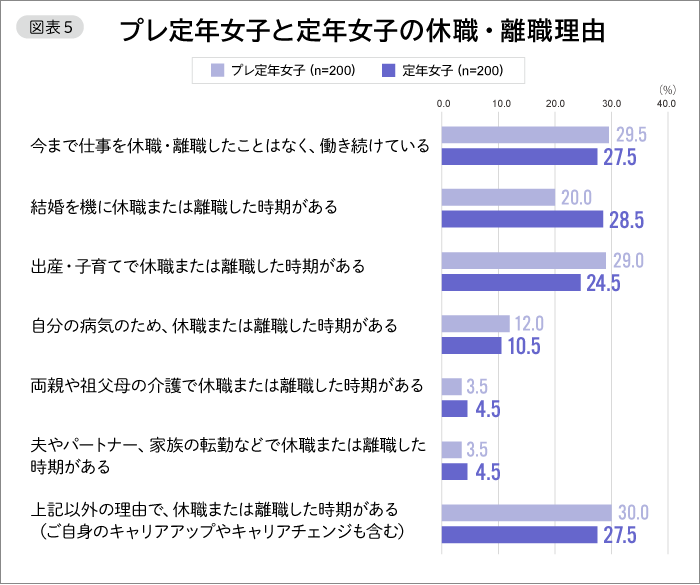
「定年女子」の職場に対する満足度
「定年女子」は今の職場について、どのように評価しているのでしょうか。満足度とその理由に注目します。
51.5%が今の職場には「満足している」と回答。一方、「満足していない」は27.5%にとどまり、自分を生かせる場と役割、メリハリある働き方が満足感につながっている。
今の職場に満足している理由は、「自分の居場所がある(果たすべき役割がある)」(52.4%)「適切な勤務時間・休日がある」(51.4%)など。お給料ではなく、自分自身を生かせる場所と役割、勤務時間と休日のメリハリが、定年を控えた「定年女子」の満足感につながっていました。また、勤務地、転勤がないこと、ワークライフバランスや福利厚生といった、働きやすさ、続けやすさを担保する要素も満足につながっていると考えられます。
職場で「高給与・好待遇」「良好な人間関係」「自分に対する適切な評価」「やりがい」が得られないと不満が。
一方、不満理由については、「給料や待遇面が良くない」(65.5%)、「職場の人間関係が良好でない」(54.5%)、「自分のことを適切に評価してもらえていない」(43.6%)、「日々の業務にやりがいを感じられない」(32.7%)などが上位に挙がりました。働きに見合わない報酬、周囲の人間関係や自分に対する評価が適切でないこと、やりがいのなさが「定年女子」の職場への不満を募らせています。
「定年女子」の職場の満足度は、いかに自己肯定感を感じながら、働きやすい環境下で、良好な人間関係を保ちながら働けるか、と深く関係していることが見えてきました。
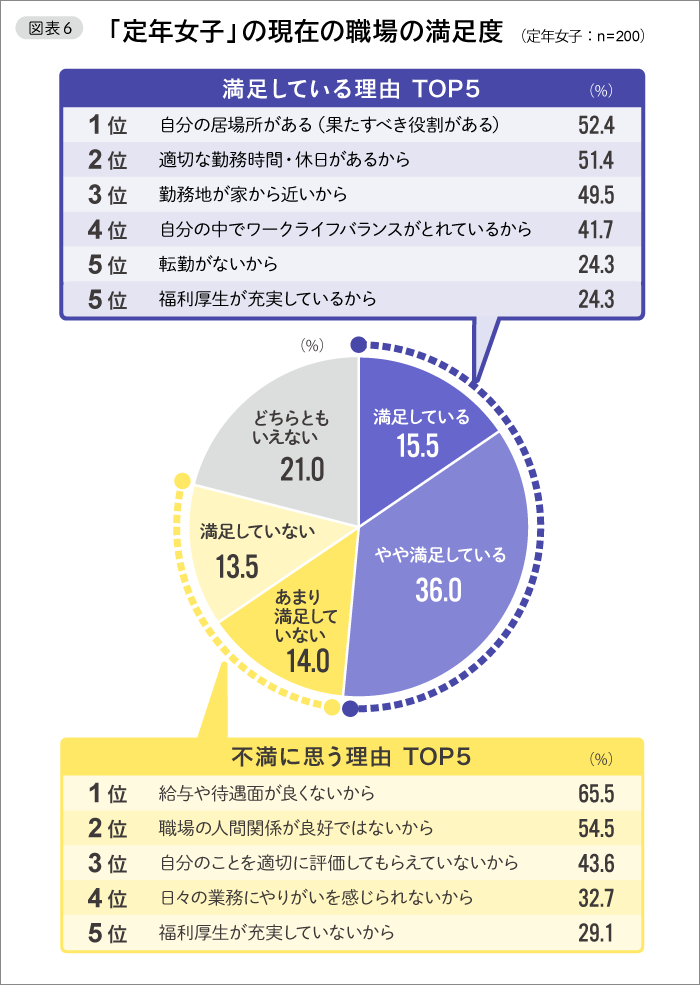
「定年女子」の女性活躍社会に対する思い
女性の活躍については賛成だが、実際の管理職志望は少数派。
図表7を見ると、「女性活躍社会に賛成である」と回答した人は79.5%と多数で、「女性の管理職がもっと増えるべきだ」という回答も67.0%と多い一方、管理職未経験者で「(部長以上の)管理職になりたい/なりたかった」と答えた人は18.1%と少ないことが分かります。
適正な評価や自分を生かせる場があることが、職場の満足感につながっている「定年女子」。女性が活躍できる社会には賛成するが、自身が管理職のポストに就いて職責を果たすことについては、少し心理的なハードルがあるようです。
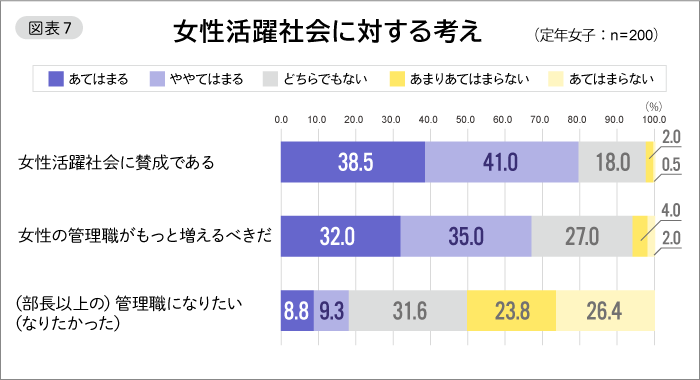
【「定年女子調査」実施概要】
・対象エリア:全国
・調査手法:インターネット調査
・対象者条件およびサンプル数:
A. 定年のある企業に正社員として働く50代女性 400ss
※プレ定年女子=50~54歳 200ss
定年女子=55~59歳 200ss
B. 定年のある企業に正社員として働き、定年を体験した60~64歳女性 200ss(※)
※ポスト定年女子
「定年後も働いている」人=仕事継続組 100ss
「定年後は仕事をしていない」人=リタイア組 100ss
・サンプル総数:600ss
・調査期間:2019年12月
・調査機関:電通マクロミルインサイト
この記事は参考になりましたか?
著者

小松 祐子
株式会社 電通
一貫して戦略プランニングに従事。 ブランディング、コンサルティング、商品開発や事業・マーケティング・コミュニケーション戦略策定、インナー施策開発、リサーチ、ファシリテーションなどホリスティックなソリューションを提供。 電通シニアプロジェクトメンバー、電通ママラボ主幹研究員

